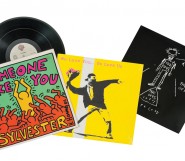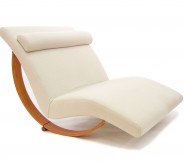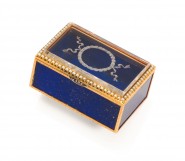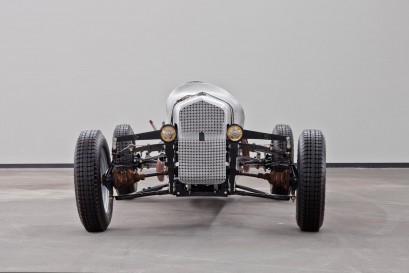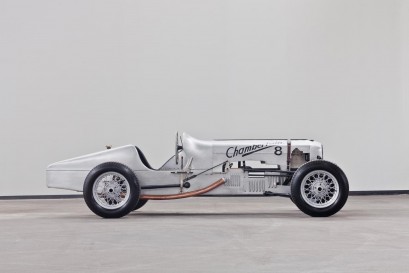Lot #74 - THE CHAMBERLAIN 8
-
Auction House:Mossgreen
-
Sale Name:Collectors’ Cars, Motorcycles & Automobilia
-
Sale Date:27 Nov 2016 ~ 2.30pm
-
Lot #:74
-
Lot Description:THE CHAMBERLAIN 8
c1929 and 1935 -
Notes:"We didn't buy an engine and gearbox and alter them round, or put an Amilcar axle in a MG chassis. We designed and built it all". - Bob Chamberlain. Most people involved in the history of Australian motor racing during the last 95 years would concur that there has never been another racing car quite like the Chamberlain 8. It's a baffling wonderment and a certain example of the old saying: "beauty is in the eye of the beholder". Is this piece of automotive mastery at best an incongruous piece of machinery that never quite worked, or is it the most originally conceived masterpiece of automotive engineering ever seen? Most importantly, this work of mechanical genius that was conceived in 1928, and the creation of its astonishing engine in 1935, holds the distinction of being the only racing car completely designed and built in Australia without the use of components from other makes. Alan Hawker "Bob" Chamberlain was a young engineer from Melbourne, a brilliant shining light amidst the gloom of the Great Depression and he conceived the plans for his own car in a nation that had a limited car manufacturing industry. Necessity was the mother of invention as everything considered crucial was 12,000 miles away which imposed a lengthy wait. Automotive parts were prohibitively expensive in Australia and anything ordered from overseas took weeks to arrive by sea. The most astounding impact of this extraordinary piece of engineering history coming into existence, is that not one but eight areas of mechanical innovation contribute to the uniqueness of the Chamberlain 8. At this point, it should be clarified that the number 8 used in the Chamberlain's model identification refers to the number of pistons rather than the cylinders or other points of its mechanical innovation. What is astonishing is that even one of the following ground-breaking engineering achievements, let alone all of them, took place during such an early period of automotive development in Australia! These ground-breaking features included: A four-cylinder supercharged two stroke engine with stepped bores, vertically opposed eight pistons and two crankshafts, one of which runs through the skirts of the top pistons; An engine which runs up to 8000 rpm; Twin Ignition with two plugs per cylinder, producing 64,000 sparks per minute (from eight coils) at 8000 engine rpm; Front-wheel drive with inboard brakes; Four-wheel independent suspension; A space frame of small diameter tubes, much of it triangulated; An 1100 cubic centimetre 85+ bhp motor; The entire car was built in Australia. Leading Specifications of the Chamberlain 8 Racing Car: Year of construction: 1928 (car) & 1935 (engine) Engine: 4 cylinders, 1078cc, two - stroke with two crankshafts & eight opposed pistons Carburation: One - Vacturi carburettor with Rootes-type supercharger Gearbox: Chamberlain, 3 - speeds Drive: Chain to front axles from the gearbox via a bevel drive taken from the bottom crankshaft. Chassis frame: Fabricated space-frame Front & rear suspension: Transverse semi-elliptic springs Brakes: Front - drums with external contracting bands Rear - drums with internal expanding bands Tyre size: 350 x 15 Dimensions: Overall length - 144 inches; Wheelbase - 98 inches; Track - 55 inches front & rear Weight: 550kg Top Speed: 112 mph For the purpose of this auction catalogue description, a brief outline of the cars' construction, provenance and an update on the current condition of the car has been detailed. A comprehensive book "The Chamberlain - An Australian Story", by John Hazelden, has been written to honour both the man and the machine. References will be drawn from that book as well as various historic motoring articles for race results and the Chamberlain's marvellous antics of the times. In its first construction, the Chamberlain was a Special in that in 1928 its first engine was from an Indian Daytona, purchased from Rhodes Motor Cycle Company. Working nights and weekends with fellow engineer and old school mate, Eric Henry Price, the Indian engine was fitted to the Chamberlain space-frame. Selection of the Indian engine was a good choice as it had the desired power-to-weight ratio as, in 1920, the first official World Land Speed record of 101mph was established at Daytona Beach on a 998cc V twin Indian. In addition, Indian had a world-wide reputation as a police bike, including in Australia. Eric Price's concept of using the Indian motor and Bob's inspiration for front-wheel drive, a startling innovation for the times, brought to being The Chamberlain Special, proudly bearing the makers name. Bob never intended his name to be added to yet another Australian Special which he referred to as "lashed up from other parts". Therefore, he set about creating a revolutionary space frame that had great rigidity. The car's beautiful bird-like aluminium body was built by H.C Dusting of High St, Kew, renowned for their sidecars, high-quality welding and coachwork. This elegant, streamlined, hand crafted body with its pointed tail, strikes a handsome stance equal to the most stylish designs of European mono-posto racing cars of the era. All details of this car are a credit to the Australians who applied their skills to making Bob's technical wonder-car quite exquisite. For example, the radiator was made by running strips of tin plate through the gears of a lathe and delicately soldering them together. To reduce drag, an under -shield, running the length of the car, was devised. The attitude at which the chassis and body stood with the wheels somewhat stretched out gave the impression of a flying creature and a nick-name, The Beetle, was coined. In 1930, an Age newspaper article on the Chamberlain stated: "With its bright, shiny, aluminium body, it looks like a smaller edition of the Silver Bullet. It can accelerate to a speed of 80 miles per hours in half a mile and it is able to make a complete hairpin bend at 55 miles per hour with perfect safety. If the police will let me," said Allen Hawker Chamberlain, "I am willing to bet 20GBpounds to a packet of cigarettes that I can go up Swanston Street at 55 miles per hour and without slackening speed, turn completely round and come back down again at the same speed." From 1930 to 1935, constant testing failures occurred in competitions with its various motorcycle engine configurations. Comprehensive historical accounts and results of these outings are available, including attempts in the Australian Grand Prix in 1931 and 1933. Quoting The Chamberlain Special - An Australian Story: "It was obvious; the Beetle had excellent handling qualities and, despite all the trouble it gave, most of the problems were confined to the bored out Indian 1115cc power plant. There were never any worries with the chassis, suspension or transmission. Accounts of the independent suspension gripping and crab-crawling the ground on take-off while showering the driver with dirt and gravel are well-documented. Clearly here was a motor car begging to have a better engine to ensure it achieved its undoubted potential". And ultimately, "The engine that Bob and Eric gave nine lives to was never heard of again." Even so, throughout the 1930's, the Chamberlain became an icon even in "the Mother Country", where the prestigious English magazine, Autocar, was writing about the racing endeavours of the Beetle. In the meantime, the Chamberlain's enterprising businesses had been evolving with ingenuity. The issues Bob and Eric had experienced could be attributed to the lack of "first grade pistons made of first grade piston alloy," strong enough for the Indian's increased compression. This led Bob to travel overseas to study piston production and to expand his newly established piston making company. The Beetle was destroying them at a pretty high rate and this led Bob to making his own. In 1932, the business moved in to a small factory in King St, West Melbourne and in 1934 Bob gave the Beetle to his brother, Howard Francis "Bill" Chamberlain, hoping to give the car a new lease on life. Equally as bold and brilliant as Bob, Bill had a dream to build a revolutionary record beating engine. Bill believed that to perform well in endurance racing, the car needed a water cooled motor, so he set about designing one from scratch. Four years later and after exhausting redrafting attempts with the design, Bill successfully built a supercharged, water-cooled, vertical, in-line, four-cylinder, two-stroke engine with two pistons per cylinder but not without the devotion of enormous time, determination and imagination. His original drawings, pencilled on cartridge paper at the family dining room table, still exist and will remain with the Chamberlain 8 as an integral part of its enduring history. The manufacture of this engine commenced in 1935 and proved to be an engineering feat. Bill Chamberlain's engine has been described as the most elaborate ever in its originality and is the same engine accompanying the Chamberlain 8 today. There is no room for scepticism about this entirely Australian-built car and this is a testament to Bill and Bob's unique designs. With all its unconventional methodology, it was forged, machined and made entirely in the Chamberlain factory. Ultimately, did this extremely innovative engine design work? It was fast and it broke timed records, but at the end of most of its competition laps, the engine would misfire and cause damage. The reason was that the spark-plugs of the day were mica-insulated and could not be relied upon for the demands that were placed on them. This resulted in the Chamberlain 8 engine's lack of total reliability in the pre-war period. During the war, the car was stored at the Chamberlain's business premises, Rolloy and Australian Ball Bearing Company, in Salmon St, Port Melbourne. After the war, the motor racing fraternity of Melbourne was back on the track with renewed enthusiasm. New hill-climbs were sort and clubs were formed with a highly competitive spirit, but none so much as the Chamberlain's cousin Harry "Jim" Hawker. He replaced the engine's pistons with new ones and specially made his own cooler spark-plugs with the assistance of Leggets Products who had Olympic spark plugs. These plugs were made with a new insulation material made from aluminium oxide. Jim Hawker modified them by roughly reshaping the hot end to make extremely cold heat range plugs. They were then reshaped by slowly rubbing the material away by using a very soft grinding wheel - a precursor to the diamond wheel of today. Olympic assisted further by fitting the centre electrodes. The bodies were then baked and Jim cut them to suit. With 8 plugs to a set, a large quantity of spares was needed. The pattern maker made a beautiful wooden box emblazoned with Chamberlain 8 in which to store this huge range of hand-made plugs. Now with a good supply of spark plugs, "so cold I was laughed at," they never used warm-up plugs again. With a reconditioned engine and these hand-made plugs, the Beetle was ready to fire in anger. It was entered to Mt Tarrangower Hillclimb and won the under 3000cc class. Euphoria was high within the team. Bob, who was said to be out of control during the climb, retorted that he did manage to keep clear of the obstacles, and is quoted as saying, "The Beetle was running so well it deserved this chance, it certainly woke up the natives and the crowd knew we were there." The exhaust note of this car is renowned due to the two-stroke giving twice as many revolutions, perhaps the equivalent noise to 16,000 revs or louder than a bike running at 14,000 revs today. Combined with the supercharger and a three-inch exhaust bore, the result is a high-pitched scream likened to a piece of calico being ripped. Amusingly, its plume of billowing smoke is as famous as the car itself! "The amazing quality and the sound emitted by the large, dual exhaust pipes were either exhilarating or unbearable depending on your point of view." - Phil Irving. Bob Chamberlain died in 1992, and the Chamberlain 8 was left to his three children. Initially the car was acquired by Jeff Dutton and destined for static display in his stylish showroom in Church Street Richmond, but Mr. John Hazelden bought the car almost immediately from Dutton Rare Cars with the purist of intentions; to preserve and present it at Historic motor racing meetings for the enrichment of the Australian public. When he acquired the car, Hazelden found the various accoutrements that will mostly accompany the car at auction. Throughout his dedicated custodianship he undertook the compilation of the historical account enshrined in the book, "The Chamberlain - An Australian Story". As an example of his dedication, Hazelden and his young son spent days scraping some 4" of encrusted dirt away from the underside of the sheet-metal under-tray made by H.C. Dustings - evocative traces of the car's 60-year racing history. He re-introduced Harry "Jim" Hawker to the Chamberlain 8 who then conducted a series of visits to diagnose the cars mechanical condition which enabled Hazelden to collate information directly from Hawker inspiring him to publish the book. He wrote, "The Beetle is an extraordinary piece of machinery. It defies convention and extreme care is necessary when working on it or contemplating any change. At a very early stage I learnt a valuable lesson; do not fiddle-instead think...The car is beautifully thought-out and built and it seems there is always a reason to what may seem a fault. It would appear there are very few." Consequently, Jim oversaw and advised on adjustments to the mechanicals and was then invited to drive the car at the 1995 Rob Roy Hillclimb. After a respectable and exciting run up the hill, Jim said: "I would not have known the condition of the car until I drove it but I found it mechanically in very good shapeÉIt needs a few minor adjustments to the timing, and then it will in tip-top performance conditionÉso many people remarked how well prepared it looked, and that is to John's credit." The Chamberlain 8 competed in several Hillclimbs as well as the 1996 Geelong Speed Trials in the Tribute to Australian Specials. It was also an invited guest in the Super Exotics and the Australian Collection at the 1997 Australian Grand Prix while in John Hazelden's ownership In December 2007, the car was acquired by the current owner. Throughout this custodianship the Chamberlain 8 has undergone considerable and careful preservation to the chassis and body, dashboard and instruments. During this restoration program care was taken to protect the provenance and original patina of the car so beautifully made by H.C. Dusting, while at the same time ensuring the car was structurally safe through an x ray/crack detection process on the frame and suspension. The only part replaced was the rusted sheet-metal under-tray which was made with the exact pressing detail to the original floor tray. The original undertray accompanies the car. New laced wire wheels representing the period have been especially built. Its original solid wheels accompany the car. The Berk supercharger was reconditioned in 2008. All the original elements have been saved and will accompany the car. A precis of the restoration work that has been carried out is available on request. While in this ownership, the unique engine has been removed from the chassis for reconditioning but the works have not been undertaken. Included with the sale is an impressive, period, mixed-media mechanical display piece featuring the internal workings of the Chamberlain 8 internal combustion engine. It has a hand winder and is mounted in a contemporary timber presentation case with plaque, 56cm high x 21cm wide x 3cm deep. Also included is the timber box containing a selection of Chamberlain 8 spark plugs with an interesting pink cutaway spark plug which is an early example designed and built by Jim Hawker to keep the engine running. Most significantly, these unique items are supported by a group of important blueprint designs of the vehicle, hand-drawn by Bob Chamberlain in candlelight in the Mallee, and the original engine drawings by Bill Chamberlain drawn at the family dining room table. A box of moulds which appear to have been used to manufacture the custom parts during its original construction accompany the car. Also included with the car is the prototype Chamberlain Marine outboard motor which in itself was an engineering feat. In the 2015, National Gallery of Victoria exhibition, Shifting Gears, the Chamberlain 8 was one of an elite selection of all-Australian built and designed cars, specially chosen for their contribution to Australian automotive history. This exquisitely beautiful 20th Century Australian icon possesses all the collective ideas, craftsmanship and sheer blood and grit of the famous Chamberlain Brothers. It is most proudly offered at auction by Mossgreen Collectors' Cars as it epitomises racing, rarity and collectability in its most pure form. It tells a story of Melbourne and its automotive high achievers and pulses with the heartbeat of a time when people's spirits were free and could turn their hands to Ôhaving a go'. The Chamberlain was invited to participate at the Goodwood Festival of Speed in 2008 but unfortunately the restoration was not complete by then. The opportunity to acquire the Chamberlain 8 is unlikely to come around again. Its museum quality is undeniable, as is its importance to our history and culture. This vehicle will be sold unregistered
-
Estimate:A$280,000 - 380,000
-
Realised Price:
-
Category:Automobiles & Accessories
This Sale has been held and this item is no longer available. Details are provided for information purposes only.
